University Name: JetBlue Airways Fuel Hedging Case Study Analysis
VerifiedAdded on 2022/08/12
|11
|3506
|30
Case Study
AI Summary
This case study analyzes JetBlue Airways' fuel hedging strategies, focusing on the airline's response to rising fuel costs. The report explores the rationale behind hedging, various hedging instruments like swaps, options, and collars, and the associated risks and costs. It delves into the concept of crack spread, its calculation, and its volatility's impact on hedging. The study examines the price and quantity risks faced by airlines, the extent to which they should hedge, and the shift from WTI to Brent crude oil contracts for hedging. It highlights the importance of integrating hedging strategies with the overall corporate strategy, particularly given the volatile nature of jet fuel prices and the significant portion of operating costs they represent. The case study emphasizes the need for airlines to protect against fuel price fluctuations and the complexities of derivative contracts, ultimately providing insights into the financial risk management practices within the airline industry.
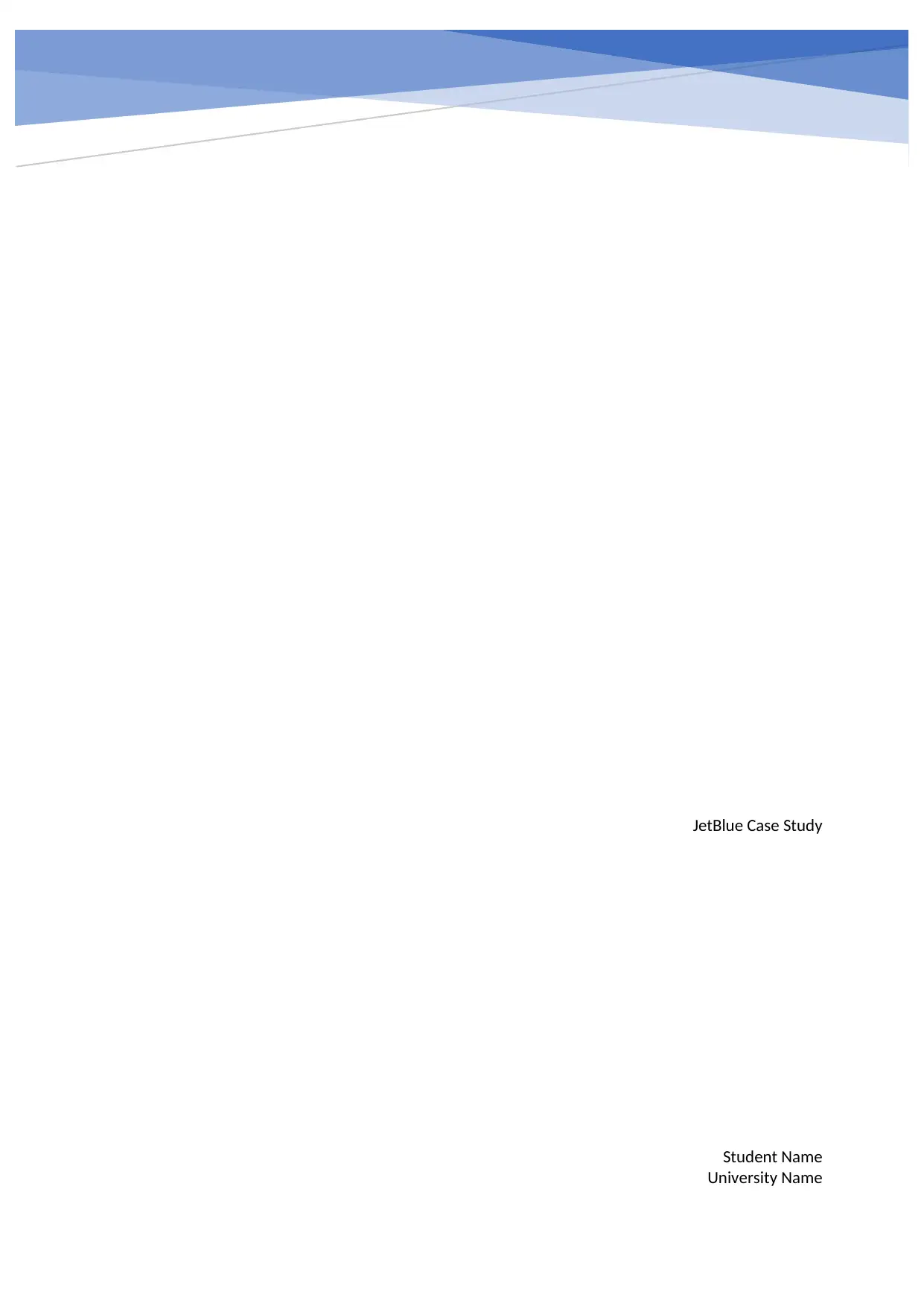
JetBlue Case Study
Student Name
University Name
Student Name
University Name
Paraphrase This Document
Need a fresh take? Get an instant paraphrase of this document with our AI Paraphraser
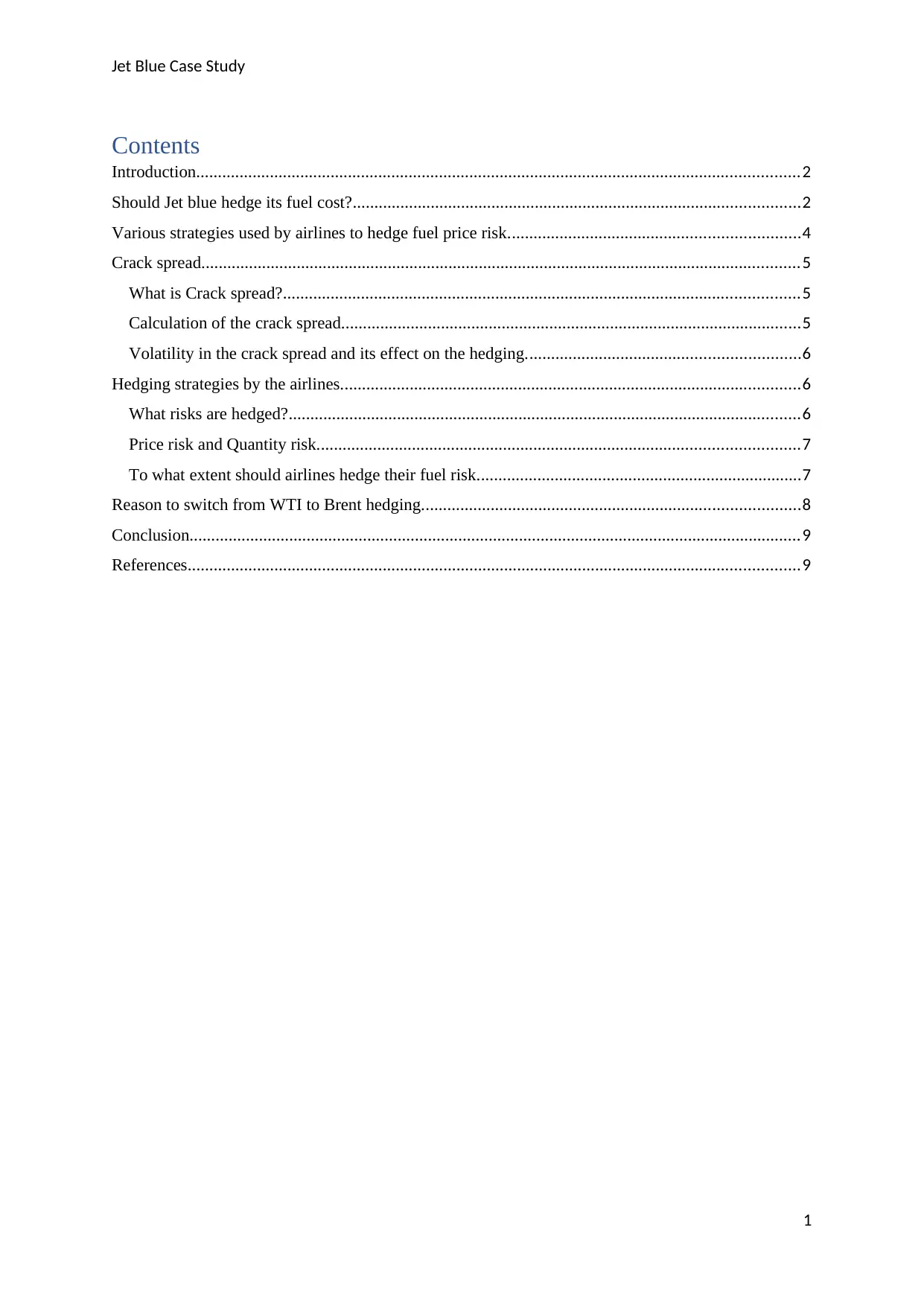
Jet Blue Case Study
Contents
Introduction...........................................................................................................................................2
Should Jet blue hedge its fuel cost?.......................................................................................................2
Various strategies used by airlines to hedge fuel price risk...................................................................4
Crack spread..........................................................................................................................................5
What is Crack spread?.......................................................................................................................5
Calculation of the crack spread..........................................................................................................5
Volatility in the crack spread and its effect on the hedging...............................................................6
Hedging strategies by the airlines..........................................................................................................6
What risks are hedged?......................................................................................................................6
Price risk and Quantity risk...............................................................................................................7
To what extent should airlines hedge their fuel risk...........................................................................7
Reason to switch from WTI to Brent hedging.......................................................................................8
Conclusion.............................................................................................................................................9
References.............................................................................................................................................9
1
Contents
Introduction...........................................................................................................................................2
Should Jet blue hedge its fuel cost?.......................................................................................................2
Various strategies used by airlines to hedge fuel price risk...................................................................4
Crack spread..........................................................................................................................................5
What is Crack spread?.......................................................................................................................5
Calculation of the crack spread..........................................................................................................5
Volatility in the crack spread and its effect on the hedging...............................................................6
Hedging strategies by the airlines..........................................................................................................6
What risks are hedged?......................................................................................................................6
Price risk and Quantity risk...............................................................................................................7
To what extent should airlines hedge their fuel risk...........................................................................7
Reason to switch from WTI to Brent hedging.......................................................................................8
Conclusion.............................................................................................................................................9
References.............................................................................................................................................9
1
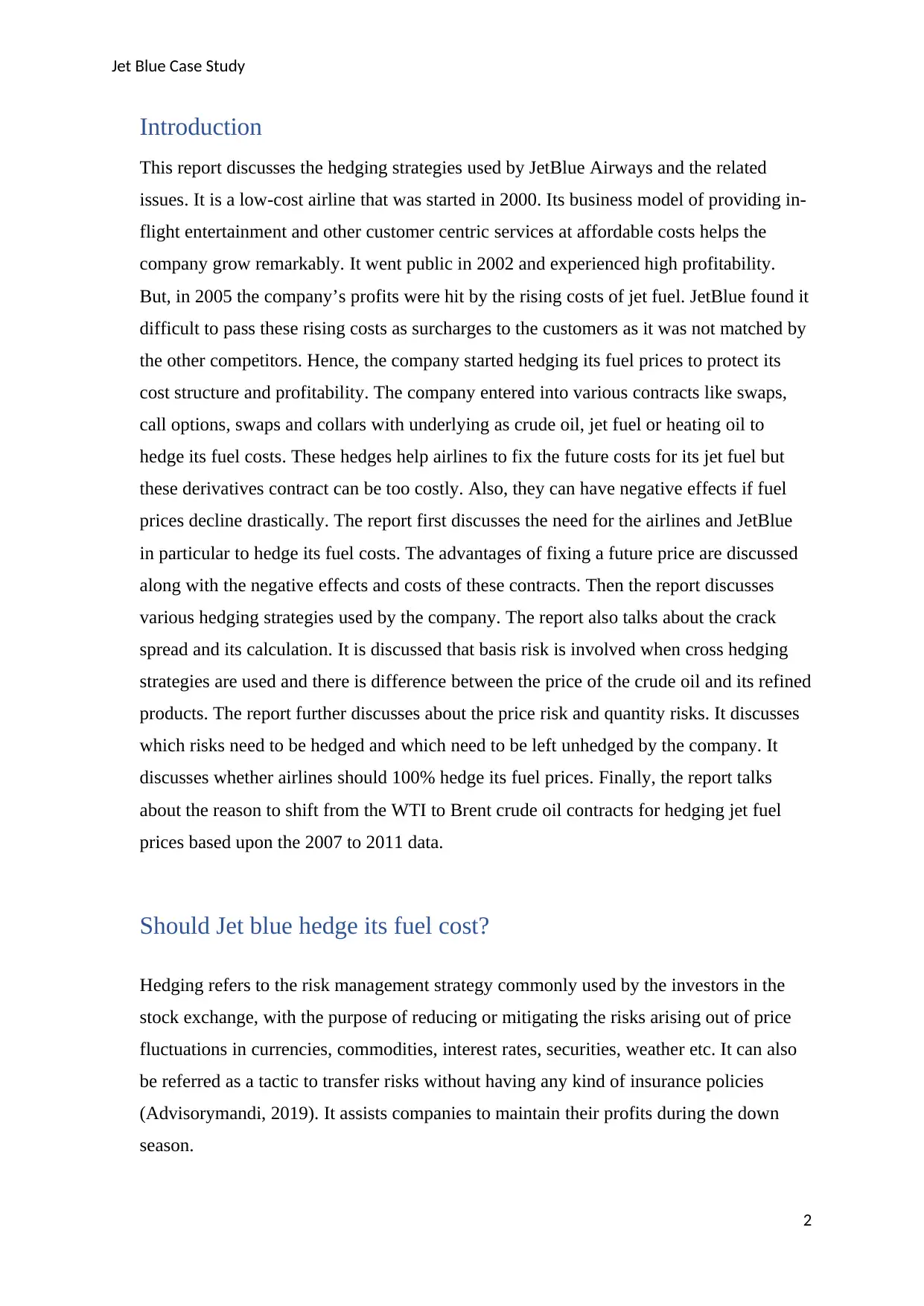
Jet Blue Case Study
Introduction
This report discusses the hedging strategies used by JetBlue Airways and the related
issues. It is a low-cost airline that was started in 2000. Its business model of providing in-
flight entertainment and other customer centric services at affordable costs helps the
company grow remarkably. It went public in 2002 and experienced high profitability.
But, in 2005 the company’s profits were hit by the rising costs of jet fuel. JetBlue found it
difficult to pass these rising costs as surcharges to the customers as it was not matched by
the other competitors. Hence, the company started hedging its fuel prices to protect its
cost structure and profitability. The company entered into various contracts like swaps,
call options, swaps and collars with underlying as crude oil, jet fuel or heating oil to
hedge its fuel costs. These hedges help airlines to fix the future costs for its jet fuel but
these derivatives contract can be too costly. Also, they can have negative effects if fuel
prices decline drastically. The report first discusses the need for the airlines and JetBlue
in particular to hedge its fuel costs. The advantages of fixing a future price are discussed
along with the negative effects and costs of these contracts. Then the report discusses
various hedging strategies used by the company. The report also talks about the crack
spread and its calculation. It is discussed that basis risk is involved when cross hedging
strategies are used and there is difference between the price of the crude oil and its refined
products. The report further discusses about the price risk and quantity risks. It discusses
which risks need to be hedged and which need to be left unhedged by the company. It
discusses whether airlines should 100% hedge its fuel prices. Finally, the report talks
about the reason to shift from the WTI to Brent crude oil contracts for hedging jet fuel
prices based upon the 2007 to 2011 data.
Should Jet blue hedge its fuel cost?
Hedging refers to the risk management strategy commonly used by the investors in the
stock exchange, with the purpose of reducing or mitigating the risks arising out of price
fluctuations in currencies, commodities, interest rates, securities, weather etc. It can also
be referred as a tactic to transfer risks without having any kind of insurance policies
(Advisorymandi, 2019). It assists companies to maintain their profits during the down
season.
2
Introduction
This report discusses the hedging strategies used by JetBlue Airways and the related
issues. It is a low-cost airline that was started in 2000. Its business model of providing in-
flight entertainment and other customer centric services at affordable costs helps the
company grow remarkably. It went public in 2002 and experienced high profitability.
But, in 2005 the company’s profits were hit by the rising costs of jet fuel. JetBlue found it
difficult to pass these rising costs as surcharges to the customers as it was not matched by
the other competitors. Hence, the company started hedging its fuel prices to protect its
cost structure and profitability. The company entered into various contracts like swaps,
call options, swaps and collars with underlying as crude oil, jet fuel or heating oil to
hedge its fuel costs. These hedges help airlines to fix the future costs for its jet fuel but
these derivatives contract can be too costly. Also, they can have negative effects if fuel
prices decline drastically. The report first discusses the need for the airlines and JetBlue
in particular to hedge its fuel costs. The advantages of fixing a future price are discussed
along with the negative effects and costs of these contracts. Then the report discusses
various hedging strategies used by the company. The report also talks about the crack
spread and its calculation. It is discussed that basis risk is involved when cross hedging
strategies are used and there is difference between the price of the crude oil and its refined
products. The report further discusses about the price risk and quantity risks. It discusses
which risks need to be hedged and which need to be left unhedged by the company. It
discusses whether airlines should 100% hedge its fuel prices. Finally, the report talks
about the reason to shift from the WTI to Brent crude oil contracts for hedging jet fuel
prices based upon the 2007 to 2011 data.
Should Jet blue hedge its fuel cost?
Hedging refers to the risk management strategy commonly used by the investors in the
stock exchange, with the purpose of reducing or mitigating the risks arising out of price
fluctuations in currencies, commodities, interest rates, securities, weather etc. It can also
be referred as a tactic to transfer risks without having any kind of insurance policies
(Advisorymandi, 2019). It assists companies to maintain their profits during the down
season.
2
⊘ This is a preview!⊘
Do you want full access?
Subscribe today to unlock all pages.

Trusted by 1+ million students worldwide
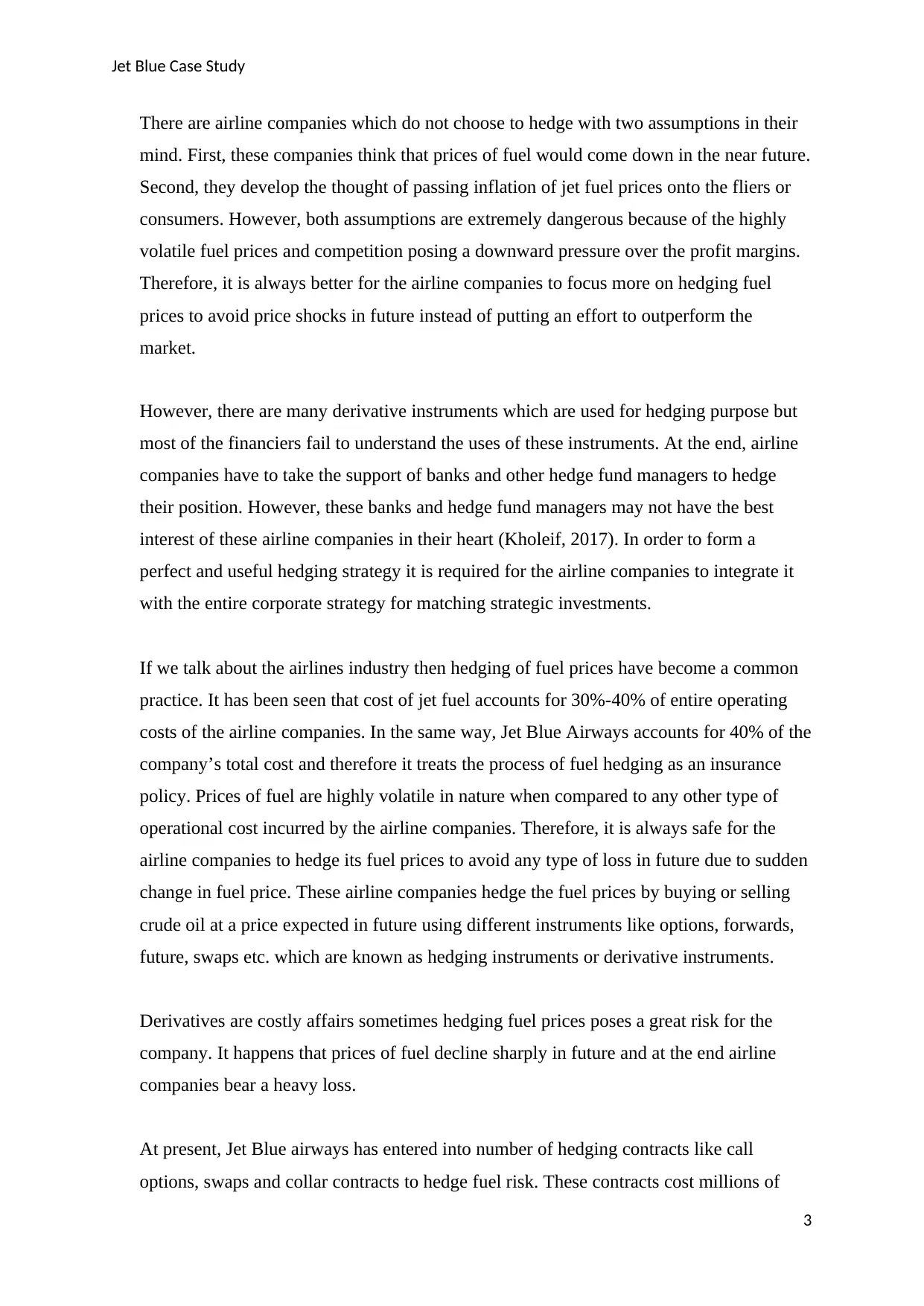
Jet Blue Case Study
There are airline companies which do not choose to hedge with two assumptions in their
mind. First, these companies think that prices of fuel would come down in the near future.
Second, they develop the thought of passing inflation of jet fuel prices onto the fliers or
consumers. However, both assumptions are extremely dangerous because of the highly
volatile fuel prices and competition posing a downward pressure over the profit margins.
Therefore, it is always better for the airline companies to focus more on hedging fuel
prices to avoid price shocks in future instead of putting an effort to outperform the
market.
However, there are many derivative instruments which are used for hedging purpose but
most of the financiers fail to understand the uses of these instruments. At the end, airline
companies have to take the support of banks and other hedge fund managers to hedge
their position. However, these banks and hedge fund managers may not have the best
interest of these airline companies in their heart (Kholeif, 2017). In order to form a
perfect and useful hedging strategy it is required for the airline companies to integrate it
with the entire corporate strategy for matching strategic investments.
If we talk about the airlines industry then hedging of fuel prices have become a common
practice. It has been seen that cost of jet fuel accounts for 30%-40% of entire operating
costs of the airline companies. In the same way, Jet Blue Airways accounts for 40% of the
company’s total cost and therefore it treats the process of fuel hedging as an insurance
policy. Prices of fuel are highly volatile in nature when compared to any other type of
operational cost incurred by the airline companies. Therefore, it is always safe for the
airline companies to hedge its fuel prices to avoid any type of loss in future due to sudden
change in fuel price. These airline companies hedge the fuel prices by buying or selling
crude oil at a price expected in future using different instruments like options, forwards,
future, swaps etc. which are known as hedging instruments or derivative instruments.
Derivatives are costly affairs sometimes hedging fuel prices poses a great risk for the
company. It happens that prices of fuel decline sharply in future and at the end airline
companies bear a heavy loss.
At present, Jet Blue airways has entered into number of hedging contracts like call
options, swaps and collar contracts to hedge fuel risk. These contracts cost millions of
3
There are airline companies which do not choose to hedge with two assumptions in their
mind. First, these companies think that prices of fuel would come down in the near future.
Second, they develop the thought of passing inflation of jet fuel prices onto the fliers or
consumers. However, both assumptions are extremely dangerous because of the highly
volatile fuel prices and competition posing a downward pressure over the profit margins.
Therefore, it is always better for the airline companies to focus more on hedging fuel
prices to avoid price shocks in future instead of putting an effort to outperform the
market.
However, there are many derivative instruments which are used for hedging purpose but
most of the financiers fail to understand the uses of these instruments. At the end, airline
companies have to take the support of banks and other hedge fund managers to hedge
their position. However, these banks and hedge fund managers may not have the best
interest of these airline companies in their heart (Kholeif, 2017). In order to form a
perfect and useful hedging strategy it is required for the airline companies to integrate it
with the entire corporate strategy for matching strategic investments.
If we talk about the airlines industry then hedging of fuel prices have become a common
practice. It has been seen that cost of jet fuel accounts for 30%-40% of entire operating
costs of the airline companies. In the same way, Jet Blue Airways accounts for 40% of the
company’s total cost and therefore it treats the process of fuel hedging as an insurance
policy. Prices of fuel are highly volatile in nature when compared to any other type of
operational cost incurred by the airline companies. Therefore, it is always safe for the
airline companies to hedge its fuel prices to avoid any type of loss in future due to sudden
change in fuel price. These airline companies hedge the fuel prices by buying or selling
crude oil at a price expected in future using different instruments like options, forwards,
future, swaps etc. which are known as hedging instruments or derivative instruments.
Derivatives are costly affairs sometimes hedging fuel prices poses a great risk for the
company. It happens that prices of fuel decline sharply in future and at the end airline
companies bear a heavy loss.
At present, Jet Blue airways has entered into number of hedging contracts like call
options, swaps and collar contracts to hedge fuel risk. These contracts cost millions of
3
Paraphrase This Document
Need a fresh take? Get an instant paraphrase of this document with our AI Paraphraser
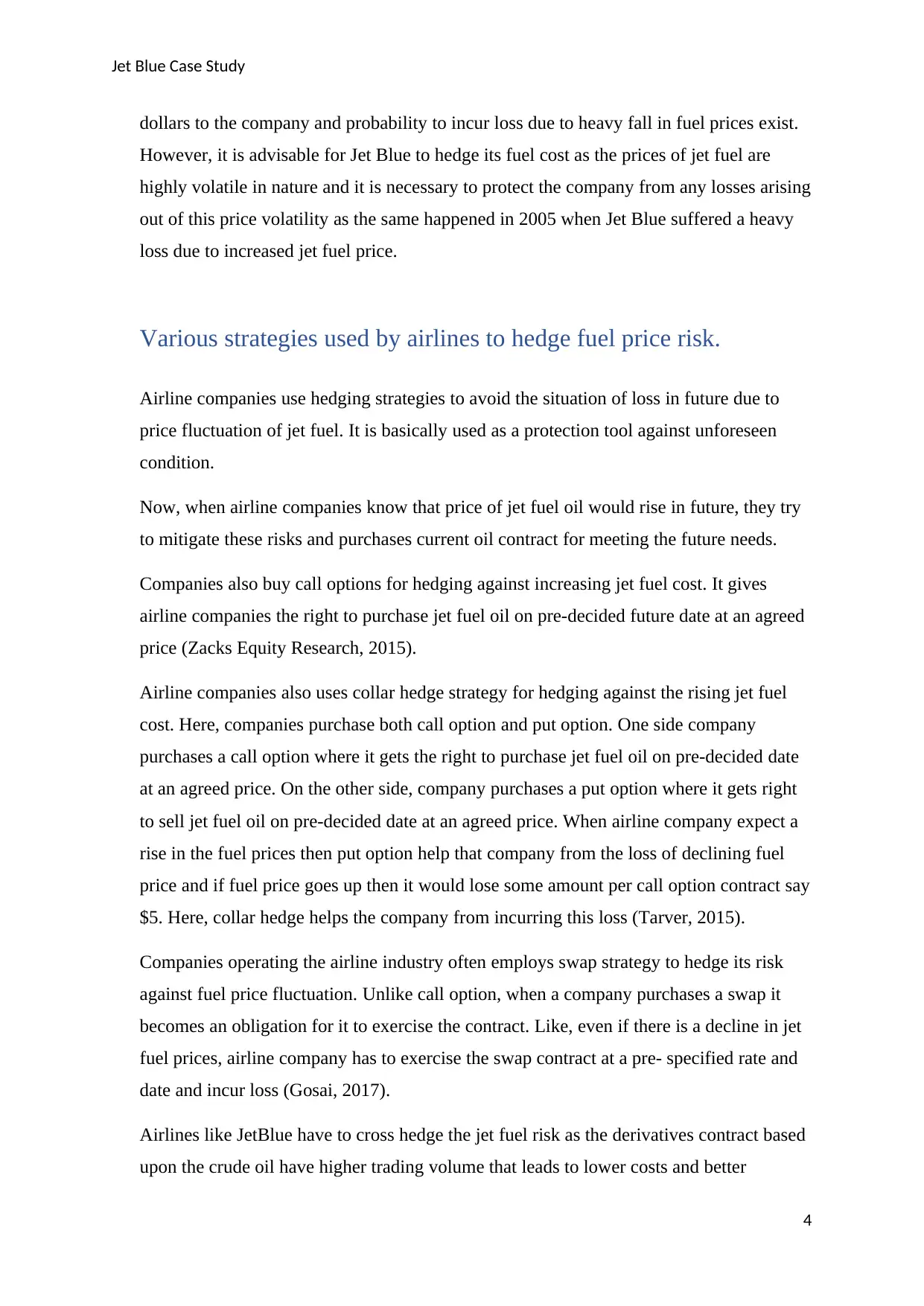
Jet Blue Case Study
dollars to the company and probability to incur loss due to heavy fall in fuel prices exist.
However, it is advisable for Jet Blue to hedge its fuel cost as the prices of jet fuel are
highly volatile in nature and it is necessary to protect the company from any losses arising
out of this price volatility as the same happened in 2005 when Jet Blue suffered a heavy
loss due to increased jet fuel price.
Various strategies used by airlines to hedge fuel price risk.
Airline companies use hedging strategies to avoid the situation of loss in future due to
price fluctuation of jet fuel. It is basically used as a protection tool against unforeseen
condition.
Now, when airline companies know that price of jet fuel oil would rise in future, they try
to mitigate these risks and purchases current oil contract for meeting the future needs.
Companies also buy call options for hedging against increasing jet fuel cost. It gives
airline companies the right to purchase jet fuel oil on pre-decided future date at an agreed
price (Zacks Equity Research, 2015).
Airline companies also uses collar hedge strategy for hedging against the rising jet fuel
cost. Here, companies purchase both call option and put option. One side company
purchases a call option where it gets the right to purchase jet fuel oil on pre-decided date
at an agreed price. On the other side, company purchases a put option where it gets right
to sell jet fuel oil on pre-decided date at an agreed price. When airline company expect a
rise in the fuel prices then put option help that company from the loss of declining fuel
price and if fuel price goes up then it would lose some amount per call option contract say
$5. Here, collar hedge helps the company from incurring this loss (Tarver, 2015).
Companies operating the airline industry often employs swap strategy to hedge its risk
against fuel price fluctuation. Unlike call option, when a company purchases a swap it
becomes an obligation for it to exercise the contract. Like, even if there is a decline in jet
fuel prices, airline company has to exercise the swap contract at a pre- specified rate and
date and incur loss (Gosai, 2017).
Airlines like JetBlue have to cross hedge the jet fuel risk as the derivatives contract based
upon the crude oil have higher trading volume that leads to lower costs and better
4
dollars to the company and probability to incur loss due to heavy fall in fuel prices exist.
However, it is advisable for Jet Blue to hedge its fuel cost as the prices of jet fuel are
highly volatile in nature and it is necessary to protect the company from any losses arising
out of this price volatility as the same happened in 2005 when Jet Blue suffered a heavy
loss due to increased jet fuel price.
Various strategies used by airlines to hedge fuel price risk.
Airline companies use hedging strategies to avoid the situation of loss in future due to
price fluctuation of jet fuel. It is basically used as a protection tool against unforeseen
condition.
Now, when airline companies know that price of jet fuel oil would rise in future, they try
to mitigate these risks and purchases current oil contract for meeting the future needs.
Companies also buy call options for hedging against increasing jet fuel cost. It gives
airline companies the right to purchase jet fuel oil on pre-decided future date at an agreed
price (Zacks Equity Research, 2015).
Airline companies also uses collar hedge strategy for hedging against the rising jet fuel
cost. Here, companies purchase both call option and put option. One side company
purchases a call option where it gets the right to purchase jet fuel oil on pre-decided date
at an agreed price. On the other side, company purchases a put option where it gets right
to sell jet fuel oil on pre-decided date at an agreed price. When airline company expect a
rise in the fuel prices then put option help that company from the loss of declining fuel
price and if fuel price goes up then it would lose some amount per call option contract say
$5. Here, collar hedge helps the company from incurring this loss (Tarver, 2015).
Companies operating the airline industry often employs swap strategy to hedge its risk
against fuel price fluctuation. Unlike call option, when a company purchases a swap it
becomes an obligation for it to exercise the contract. Like, even if there is a decline in jet
fuel prices, airline company has to exercise the swap contract at a pre- specified rate and
date and incur loss (Gosai, 2017).
Airlines like JetBlue have to cross hedge the jet fuel risk as the derivatives contract based
upon the crude oil have higher trading volume that leads to lower costs and better
4
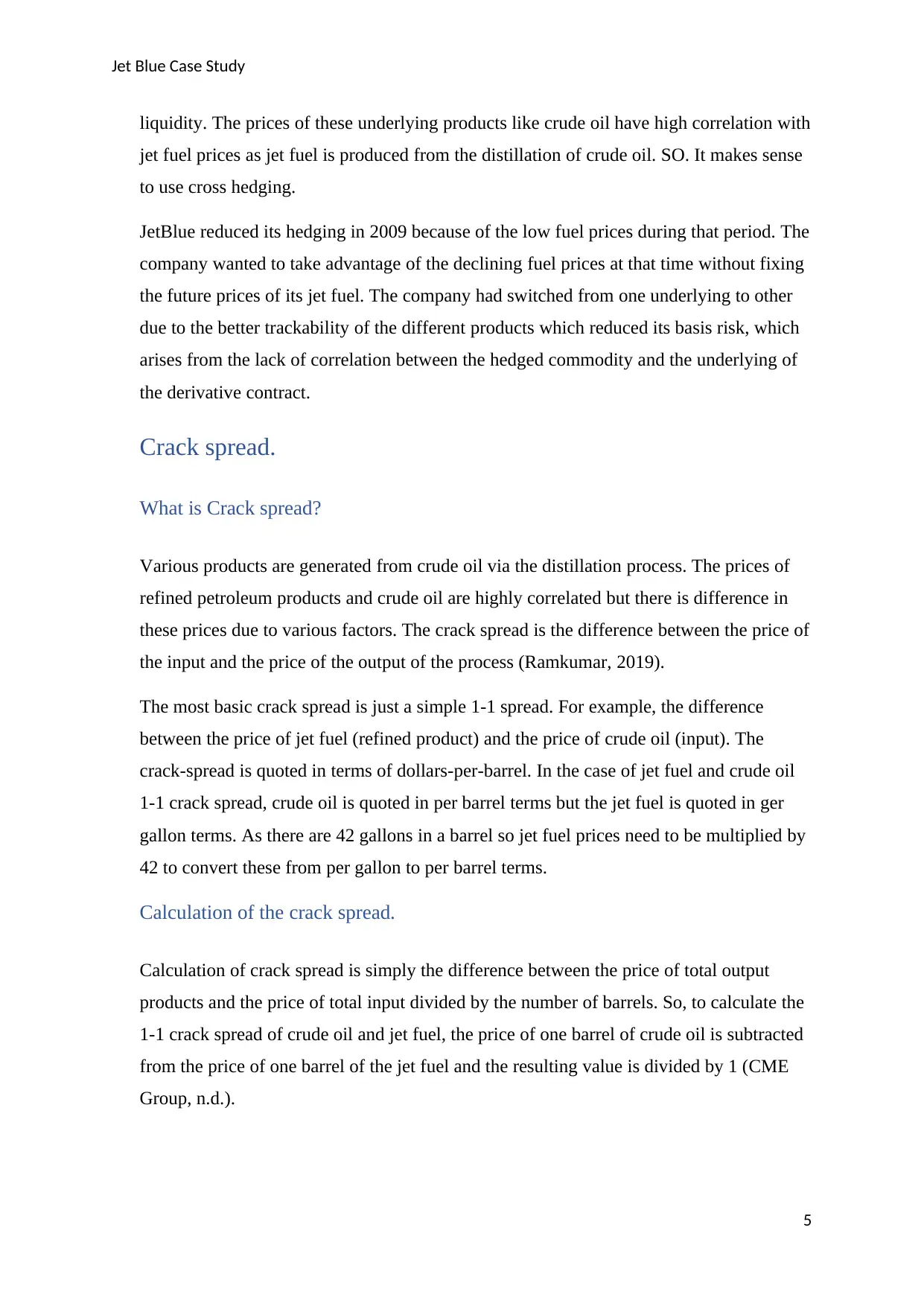
Jet Blue Case Study
liquidity. The prices of these underlying products like crude oil have high correlation with
jet fuel prices as jet fuel is produced from the distillation of crude oil. SO. It makes sense
to use cross hedging.
JetBlue reduced its hedging in 2009 because of the low fuel prices during that period. The
company wanted to take advantage of the declining fuel prices at that time without fixing
the future prices of its jet fuel. The company had switched from one underlying to other
due to the better trackability of the different products which reduced its basis risk, which
arises from the lack of correlation between the hedged commodity and the underlying of
the derivative contract.
Crack spread.
What is Crack spread?
Various products are generated from crude oil via the distillation process. The prices of
refined petroleum products and crude oil are highly correlated but there is difference in
these prices due to various factors. The crack spread is the difference between the price of
the input and the price of the output of the process (Ramkumar, 2019).
The most basic crack spread is just a simple 1-1 spread. For example, the difference
between the price of jet fuel (refined product) and the price of crude oil (input). The
crack-spread is quoted in terms of dollars-per-barrel. In the case of jet fuel and crude oil
1-1 crack spread, crude oil is quoted in per barrel terms but the jet fuel is quoted in ger
gallon terms. As there are 42 gallons in a barrel so jet fuel prices need to be multiplied by
42 to convert these from per gallon to per barrel terms.
Calculation of the crack spread.
Calculation of crack spread is simply the difference between the price of total output
products and the price of total input divided by the number of barrels. So, to calculate the
1-1 crack spread of crude oil and jet fuel, the price of one barrel of crude oil is subtracted
from the price of one barrel of the jet fuel and the resulting value is divided by 1 (CME
Group, n.d.).
5
liquidity. The prices of these underlying products like crude oil have high correlation with
jet fuel prices as jet fuel is produced from the distillation of crude oil. SO. It makes sense
to use cross hedging.
JetBlue reduced its hedging in 2009 because of the low fuel prices during that period. The
company wanted to take advantage of the declining fuel prices at that time without fixing
the future prices of its jet fuel. The company had switched from one underlying to other
due to the better trackability of the different products which reduced its basis risk, which
arises from the lack of correlation between the hedged commodity and the underlying of
the derivative contract.
Crack spread.
What is Crack spread?
Various products are generated from crude oil via the distillation process. The prices of
refined petroleum products and crude oil are highly correlated but there is difference in
these prices due to various factors. The crack spread is the difference between the price of
the input and the price of the output of the process (Ramkumar, 2019).
The most basic crack spread is just a simple 1-1 spread. For example, the difference
between the price of jet fuel (refined product) and the price of crude oil (input). The
crack-spread is quoted in terms of dollars-per-barrel. In the case of jet fuel and crude oil
1-1 crack spread, crude oil is quoted in per barrel terms but the jet fuel is quoted in ger
gallon terms. As there are 42 gallons in a barrel so jet fuel prices need to be multiplied by
42 to convert these from per gallon to per barrel terms.
Calculation of the crack spread.
Calculation of crack spread is simply the difference between the price of total output
products and the price of total input divided by the number of barrels. So, to calculate the
1-1 crack spread of crude oil and jet fuel, the price of one barrel of crude oil is subtracted
from the price of one barrel of the jet fuel and the resulting value is divided by 1 (CME
Group, n.d.).
5
⊘ This is a preview!⊘
Do you want full access?
Subscribe today to unlock all pages.

Trusted by 1+ million students worldwide
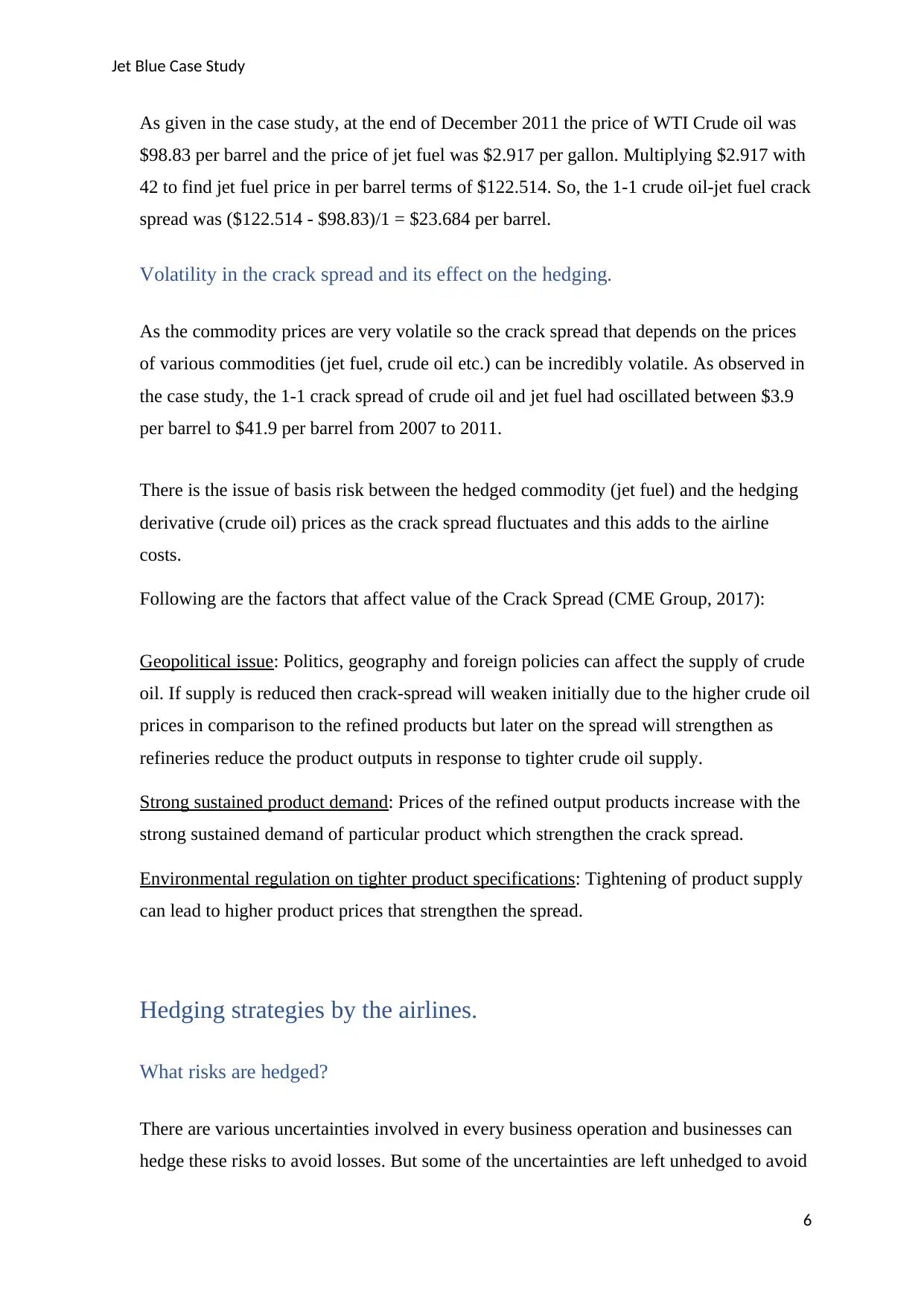
Jet Blue Case Study
As given in the case study, at the end of December 2011 the price of WTI Crude oil was
$98.83 per barrel and the price of jet fuel was $2.917 per gallon. Multiplying $2.917 with
42 to find jet fuel price in per barrel terms of $122.514. So, the 1-1 crude oil-jet fuel crack
spread was ($122.514 - $98.83)/1 = $23.684 per barrel.
Volatility in the crack spread and its effect on the hedging.
As the commodity prices are very volatile so the crack spread that depends on the prices
of various commodities (jet fuel, crude oil etc.) can be incredibly volatile. As observed in
the case study, the 1-1 crack spread of crude oil and jet fuel had oscillated between $3.9
per barrel to $41.9 per barrel from 2007 to 2011.
There is the issue of basis risk between the hedged commodity (jet fuel) and the hedging
derivative (crude oil) prices as the crack spread fluctuates and this adds to the airline
costs.
Following are the factors that affect value of the Crack Spread (CME Group, 2017):
Geopolitical issue: Politics, geography and foreign policies can affect the supply of crude
oil. If supply is reduced then crack-spread will weaken initially due to the higher crude oil
prices in comparison to the refined products but later on the spread will strengthen as
refineries reduce the product outputs in response to tighter crude oil supply.
Strong sustained product demand: Prices of the refined output products increase with the
strong sustained demand of particular product which strengthen the crack spread.
Environmental regulation on tighter product specifications: Tightening of product supply
can lead to higher product prices that strengthen the spread.
Hedging strategies by the airlines.
What risks are hedged?
There are various uncertainties involved in every business operation and businesses can
hedge these risks to avoid losses. But some of the uncertainties are left unhedged to avoid
6
As given in the case study, at the end of December 2011 the price of WTI Crude oil was
$98.83 per barrel and the price of jet fuel was $2.917 per gallon. Multiplying $2.917 with
42 to find jet fuel price in per barrel terms of $122.514. So, the 1-1 crude oil-jet fuel crack
spread was ($122.514 - $98.83)/1 = $23.684 per barrel.
Volatility in the crack spread and its effect on the hedging.
As the commodity prices are very volatile so the crack spread that depends on the prices
of various commodities (jet fuel, crude oil etc.) can be incredibly volatile. As observed in
the case study, the 1-1 crack spread of crude oil and jet fuel had oscillated between $3.9
per barrel to $41.9 per barrel from 2007 to 2011.
There is the issue of basis risk between the hedged commodity (jet fuel) and the hedging
derivative (crude oil) prices as the crack spread fluctuates and this adds to the airline
costs.
Following are the factors that affect value of the Crack Spread (CME Group, 2017):
Geopolitical issue: Politics, geography and foreign policies can affect the supply of crude
oil. If supply is reduced then crack-spread will weaken initially due to the higher crude oil
prices in comparison to the refined products but later on the spread will strengthen as
refineries reduce the product outputs in response to tighter crude oil supply.
Strong sustained product demand: Prices of the refined output products increase with the
strong sustained demand of particular product which strengthen the crack spread.
Environmental regulation on tighter product specifications: Tightening of product supply
can lead to higher product prices that strengthen the spread.
Hedging strategies by the airlines.
What risks are hedged?
There are various uncertainties involved in every business operation and businesses can
hedge these risks to avoid losses. But some of the uncertainties are left unhedged to avoid
6
Paraphrase This Document
Need a fresh take? Get an instant paraphrase of this document with our AI Paraphraser
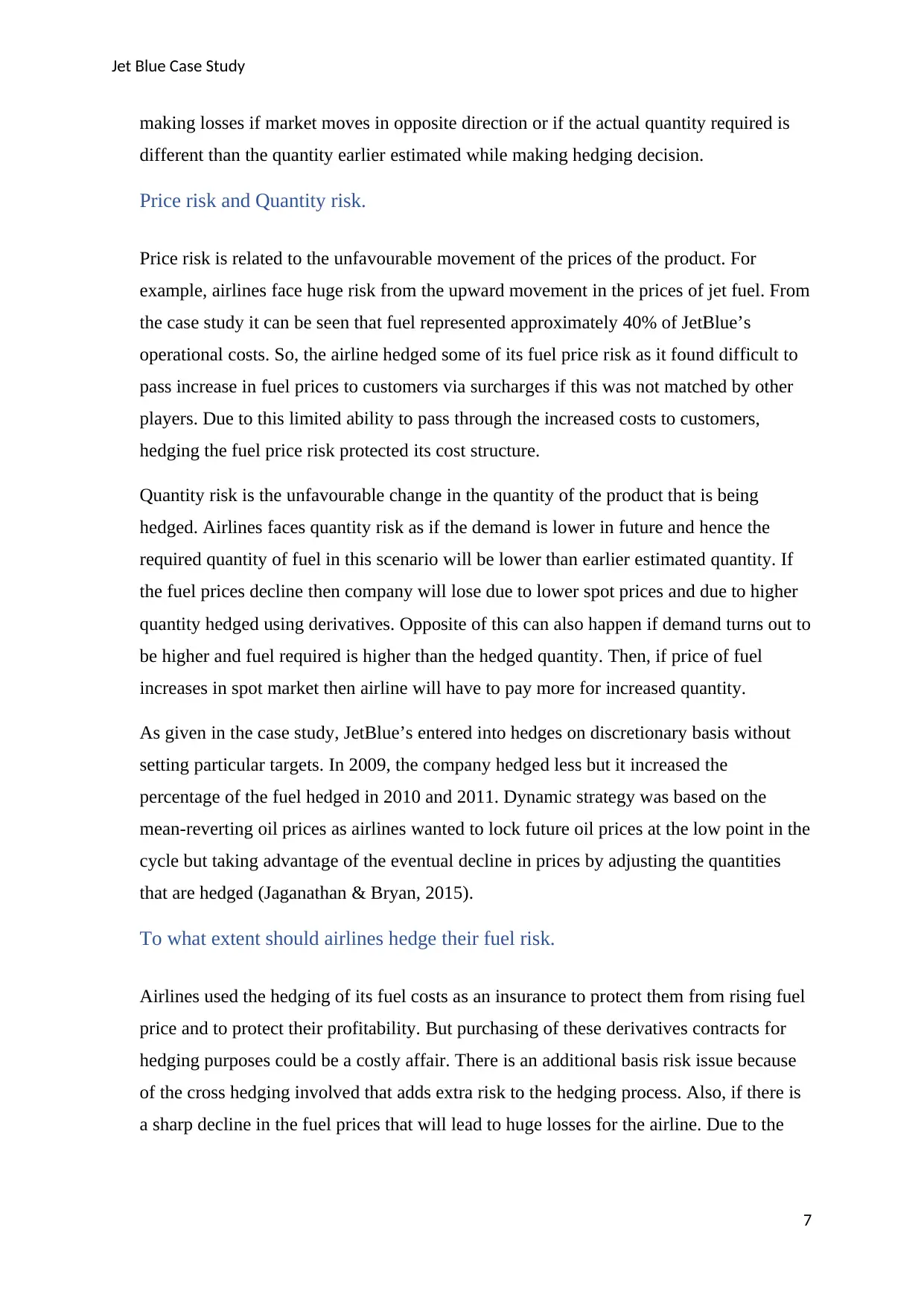
Jet Blue Case Study
making losses if market moves in opposite direction or if the actual quantity required is
different than the quantity earlier estimated while making hedging decision.
Price risk and Quantity risk.
Price risk is related to the unfavourable movement of the prices of the product. For
example, airlines face huge risk from the upward movement in the prices of jet fuel. From
the case study it can be seen that fuel represented approximately 40% of JetBlue’s
operational costs. So, the airline hedged some of its fuel price risk as it found difficult to
pass increase in fuel prices to customers via surcharges if this was not matched by other
players. Due to this limited ability to pass through the increased costs to customers,
hedging the fuel price risk protected its cost structure.
Quantity risk is the unfavourable change in the quantity of the product that is being
hedged. Airlines faces quantity risk as if the demand is lower in future and hence the
required quantity of fuel in this scenario will be lower than earlier estimated quantity. If
the fuel prices decline then company will lose due to lower spot prices and due to higher
quantity hedged using derivatives. Opposite of this can also happen if demand turns out to
be higher and fuel required is higher than the hedged quantity. Then, if price of fuel
increases in spot market then airline will have to pay more for increased quantity.
As given in the case study, JetBlue’s entered into hedges on discretionary basis without
setting particular targets. In 2009, the company hedged less but it increased the
percentage of the fuel hedged in 2010 and 2011. Dynamic strategy was based on the
mean-reverting oil prices as airlines wanted to lock future oil prices at the low point in the
cycle but taking advantage of the eventual decline in prices by adjusting the quantities
that are hedged (Jaganathan & Bryan, 2015).
To what extent should airlines hedge their fuel risk.
Airlines used the hedging of its fuel costs as an insurance to protect them from rising fuel
price and to protect their profitability. But purchasing of these derivatives contracts for
hedging purposes could be a costly affair. There is an additional basis risk issue because
of the cross hedging involved that adds extra risk to the hedging process. Also, if there is
a sharp decline in the fuel prices that will lead to huge losses for the airline. Due to the
7
making losses if market moves in opposite direction or if the actual quantity required is
different than the quantity earlier estimated while making hedging decision.
Price risk and Quantity risk.
Price risk is related to the unfavourable movement of the prices of the product. For
example, airlines face huge risk from the upward movement in the prices of jet fuel. From
the case study it can be seen that fuel represented approximately 40% of JetBlue’s
operational costs. So, the airline hedged some of its fuel price risk as it found difficult to
pass increase in fuel prices to customers via surcharges if this was not matched by other
players. Due to this limited ability to pass through the increased costs to customers,
hedging the fuel price risk protected its cost structure.
Quantity risk is the unfavourable change in the quantity of the product that is being
hedged. Airlines faces quantity risk as if the demand is lower in future and hence the
required quantity of fuel in this scenario will be lower than earlier estimated quantity. If
the fuel prices decline then company will lose due to lower spot prices and due to higher
quantity hedged using derivatives. Opposite of this can also happen if demand turns out to
be higher and fuel required is higher than the hedged quantity. Then, if price of fuel
increases in spot market then airline will have to pay more for increased quantity.
As given in the case study, JetBlue’s entered into hedges on discretionary basis without
setting particular targets. In 2009, the company hedged less but it increased the
percentage of the fuel hedged in 2010 and 2011. Dynamic strategy was based on the
mean-reverting oil prices as airlines wanted to lock future oil prices at the low point in the
cycle but taking advantage of the eventual decline in prices by adjusting the quantities
that are hedged (Jaganathan & Bryan, 2015).
To what extent should airlines hedge their fuel risk.
Airlines used the hedging of its fuel costs as an insurance to protect them from rising fuel
price and to protect their profitability. But purchasing of these derivatives contracts for
hedging purposes could be a costly affair. There is an additional basis risk issue because
of the cross hedging involved that adds extra risk to the hedging process. Also, if there is
a sharp decline in the fuel prices that will lead to huge losses for the airline. Due to the
7
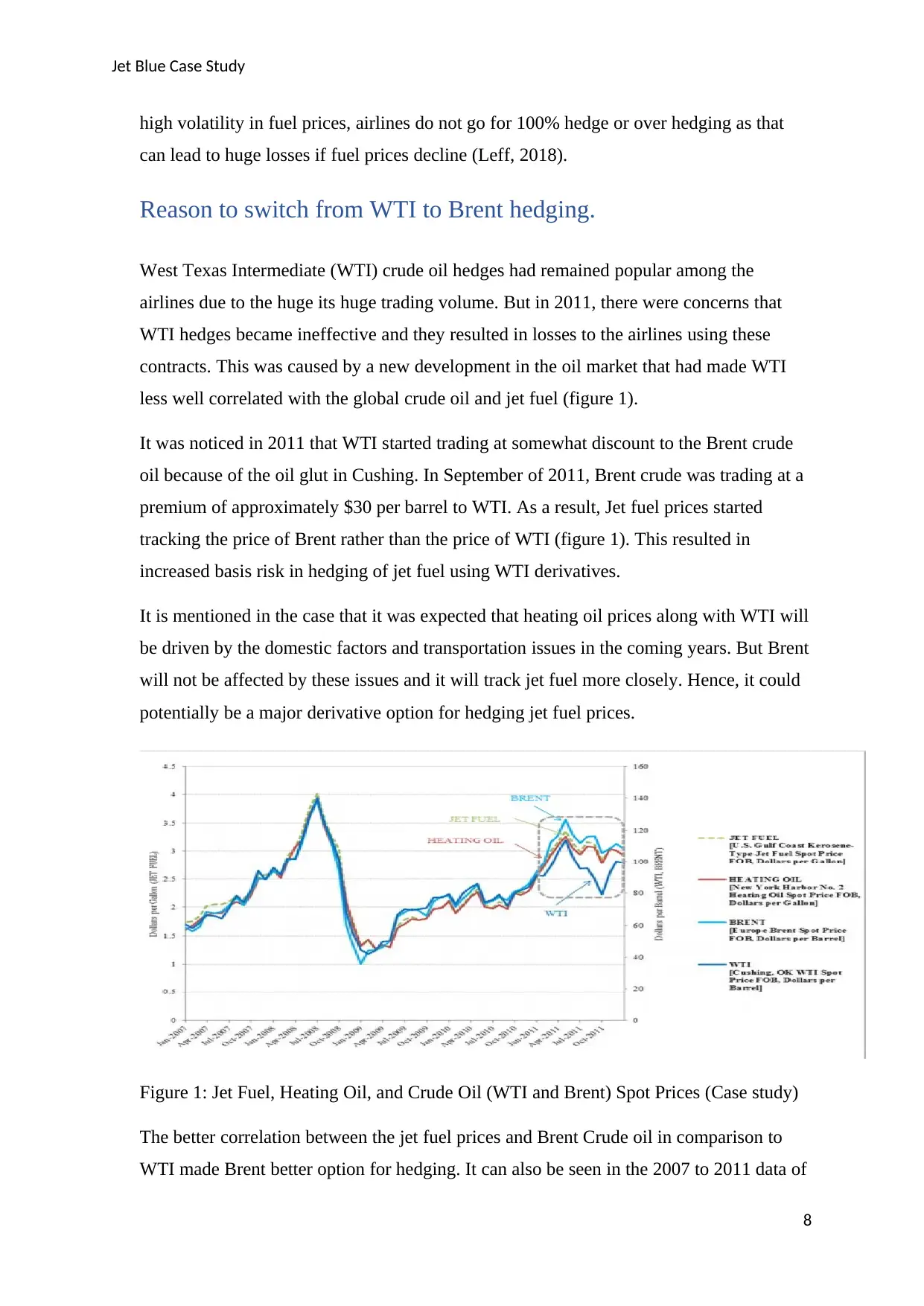
Jet Blue Case Study
high volatility in fuel prices, airlines do not go for 100% hedge or over hedging as that
can lead to huge losses if fuel prices decline (Leff, 2018).
Reason to switch from WTI to Brent hedging.
West Texas Intermediate (WTI) crude oil hedges had remained popular among the
airlines due to the huge its huge trading volume. But in 2011, there were concerns that
WTI hedges became ineffective and they resulted in losses to the airlines using these
contracts. This was caused by a new development in the oil market that had made WTI
less well correlated with the global crude oil and jet fuel (figure 1).
It was noticed in 2011 that WTI started trading at somewhat discount to the Brent crude
oil because of the oil glut in Cushing. In September of 2011, Brent crude was trading at a
premium of approximately $30 per barrel to WTI. As a result, Jet fuel prices started
tracking the price of Brent rather than the price of WTI (figure 1). This resulted in
increased basis risk in hedging of jet fuel using WTI derivatives.
It is mentioned in the case that it was expected that heating oil prices along with WTI will
be driven by the domestic factors and transportation issues in the coming years. But Brent
will not be affected by these issues and it will track jet fuel more closely. Hence, it could
potentially be a major derivative option for hedging jet fuel prices.
Figure 1: Jet Fuel, Heating Oil, and Crude Oil (WTI and Brent) Spot Prices (Case study)
The better correlation between the jet fuel prices and Brent Crude oil in comparison to
WTI made Brent better option for hedging. It can also be seen in the 2007 to 2011 data of
8
high volatility in fuel prices, airlines do not go for 100% hedge or over hedging as that
can lead to huge losses if fuel prices decline (Leff, 2018).
Reason to switch from WTI to Brent hedging.
West Texas Intermediate (WTI) crude oil hedges had remained popular among the
airlines due to the huge its huge trading volume. But in 2011, there were concerns that
WTI hedges became ineffective and they resulted in losses to the airlines using these
contracts. This was caused by a new development in the oil market that had made WTI
less well correlated with the global crude oil and jet fuel (figure 1).
It was noticed in 2011 that WTI started trading at somewhat discount to the Brent crude
oil because of the oil glut in Cushing. In September of 2011, Brent crude was trading at a
premium of approximately $30 per barrel to WTI. As a result, Jet fuel prices started
tracking the price of Brent rather than the price of WTI (figure 1). This resulted in
increased basis risk in hedging of jet fuel using WTI derivatives.
It is mentioned in the case that it was expected that heating oil prices along with WTI will
be driven by the domestic factors and transportation issues in the coming years. But Brent
will not be affected by these issues and it will track jet fuel more closely. Hence, it could
potentially be a major derivative option for hedging jet fuel prices.
Figure 1: Jet Fuel, Heating Oil, and Crude Oil (WTI and Brent) Spot Prices (Case study)
The better correlation between the jet fuel prices and Brent Crude oil in comparison to
WTI made Brent better option for hedging. It can also be seen in the 2007 to 2011 data of
8
⊘ This is a preview!⊘
Do you want full access?
Subscribe today to unlock all pages.

Trusted by 1+ million students worldwide
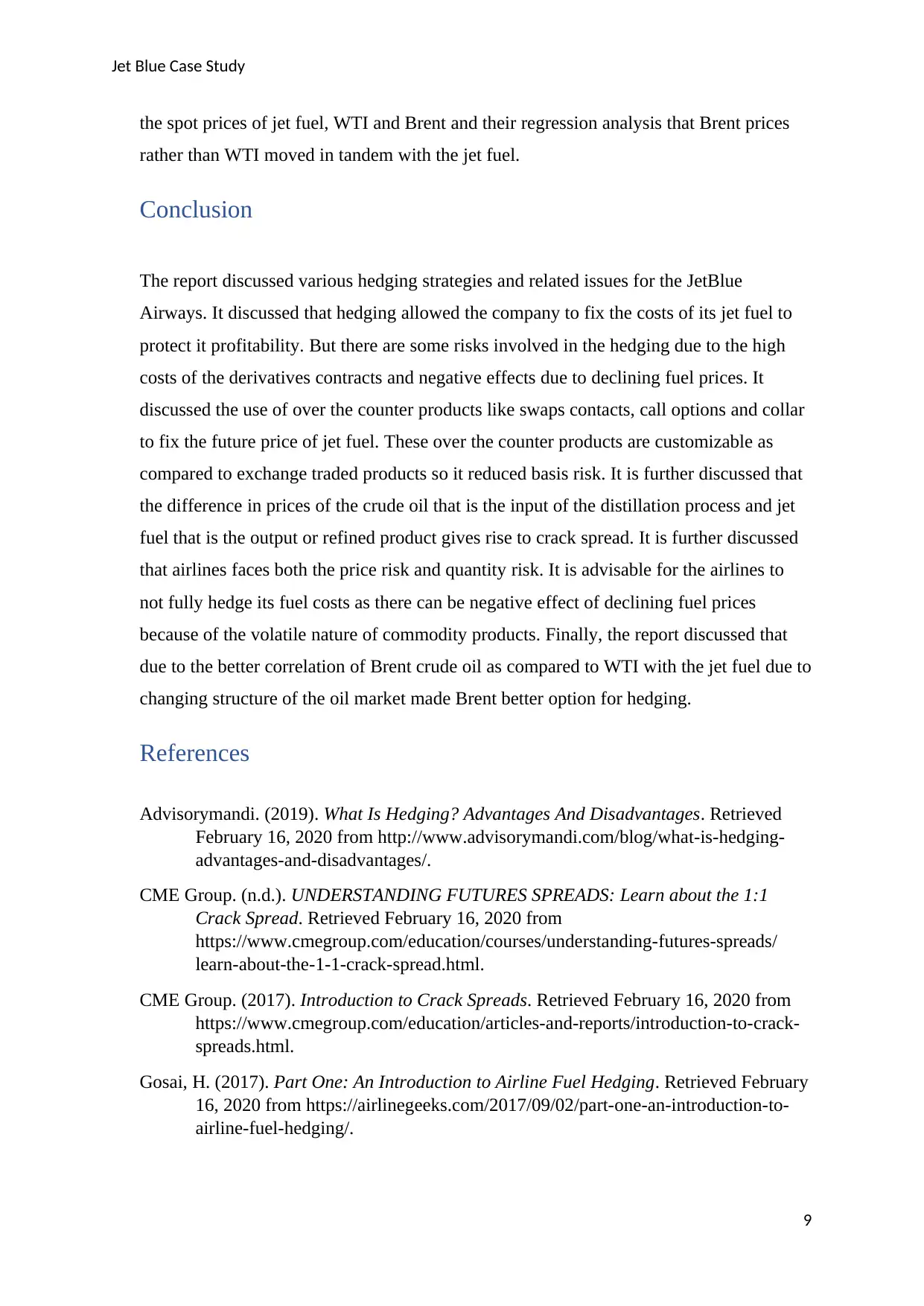
Jet Blue Case Study
the spot prices of jet fuel, WTI and Brent and their regression analysis that Brent prices
rather than WTI moved in tandem with the jet fuel.
Conclusion
The report discussed various hedging strategies and related issues for the JetBlue
Airways. It discussed that hedging allowed the company to fix the costs of its jet fuel to
protect it profitability. But there are some risks involved in the hedging due to the high
costs of the derivatives contracts and negative effects due to declining fuel prices. It
discussed the use of over the counter products like swaps contacts, call options and collar
to fix the future price of jet fuel. These over the counter products are customizable as
compared to exchange traded products so it reduced basis risk. It is further discussed that
the difference in prices of the crude oil that is the input of the distillation process and jet
fuel that is the output or refined product gives rise to crack spread. It is further discussed
that airlines faces both the price risk and quantity risk. It is advisable for the airlines to
not fully hedge its fuel costs as there can be negative effect of declining fuel prices
because of the volatile nature of commodity products. Finally, the report discussed that
due to the better correlation of Brent crude oil as compared to WTI with the jet fuel due to
changing structure of the oil market made Brent better option for hedging.
References
Advisorymandi. (2019). What Is Hedging? Advantages And Disadvantages. Retrieved
February 16, 2020 from http://www.advisorymandi.com/blog/what-is-hedging-
advantages-and-disadvantages/.
CME Group. (n.d.). UNDERSTANDING FUTURES SPREADS: Learn about the 1:1
Crack Spread. Retrieved February 16, 2020 from
https://www.cmegroup.com/education/courses/understanding-futures-spreads/
learn-about-the-1-1-crack-spread.html.
CME Group. (2017). Introduction to Crack Spreads. Retrieved February 16, 2020 from
https://www.cmegroup.com/education/articles-and-reports/introduction-to-crack-
spreads.html.
Gosai, H. (2017). Part One: An Introduction to Airline Fuel Hedging. Retrieved February
16, 2020 from https://airlinegeeks.com/2017/09/02/part-one-an-introduction-to-
airline-fuel-hedging/.
9
the spot prices of jet fuel, WTI and Brent and their regression analysis that Brent prices
rather than WTI moved in tandem with the jet fuel.
Conclusion
The report discussed various hedging strategies and related issues for the JetBlue
Airways. It discussed that hedging allowed the company to fix the costs of its jet fuel to
protect it profitability. But there are some risks involved in the hedging due to the high
costs of the derivatives contracts and negative effects due to declining fuel prices. It
discussed the use of over the counter products like swaps contacts, call options and collar
to fix the future price of jet fuel. These over the counter products are customizable as
compared to exchange traded products so it reduced basis risk. It is further discussed that
the difference in prices of the crude oil that is the input of the distillation process and jet
fuel that is the output or refined product gives rise to crack spread. It is further discussed
that airlines faces both the price risk and quantity risk. It is advisable for the airlines to
not fully hedge its fuel costs as there can be negative effect of declining fuel prices
because of the volatile nature of commodity products. Finally, the report discussed that
due to the better correlation of Brent crude oil as compared to WTI with the jet fuel due to
changing structure of the oil market made Brent better option for hedging.
References
Advisorymandi. (2019). What Is Hedging? Advantages And Disadvantages. Retrieved
February 16, 2020 from http://www.advisorymandi.com/blog/what-is-hedging-
advantages-and-disadvantages/.
CME Group. (n.d.). UNDERSTANDING FUTURES SPREADS: Learn about the 1:1
Crack Spread. Retrieved February 16, 2020 from
https://www.cmegroup.com/education/courses/understanding-futures-spreads/
learn-about-the-1-1-crack-spread.html.
CME Group. (2017). Introduction to Crack Spreads. Retrieved February 16, 2020 from
https://www.cmegroup.com/education/articles-and-reports/introduction-to-crack-
spreads.html.
Gosai, H. (2017). Part One: An Introduction to Airline Fuel Hedging. Retrieved February
16, 2020 from https://airlinegeeks.com/2017/09/02/part-one-an-introduction-to-
airline-fuel-hedging/.
9
Paraphrase This Document
Need a fresh take? Get an instant paraphrase of this document with our AI Paraphraser
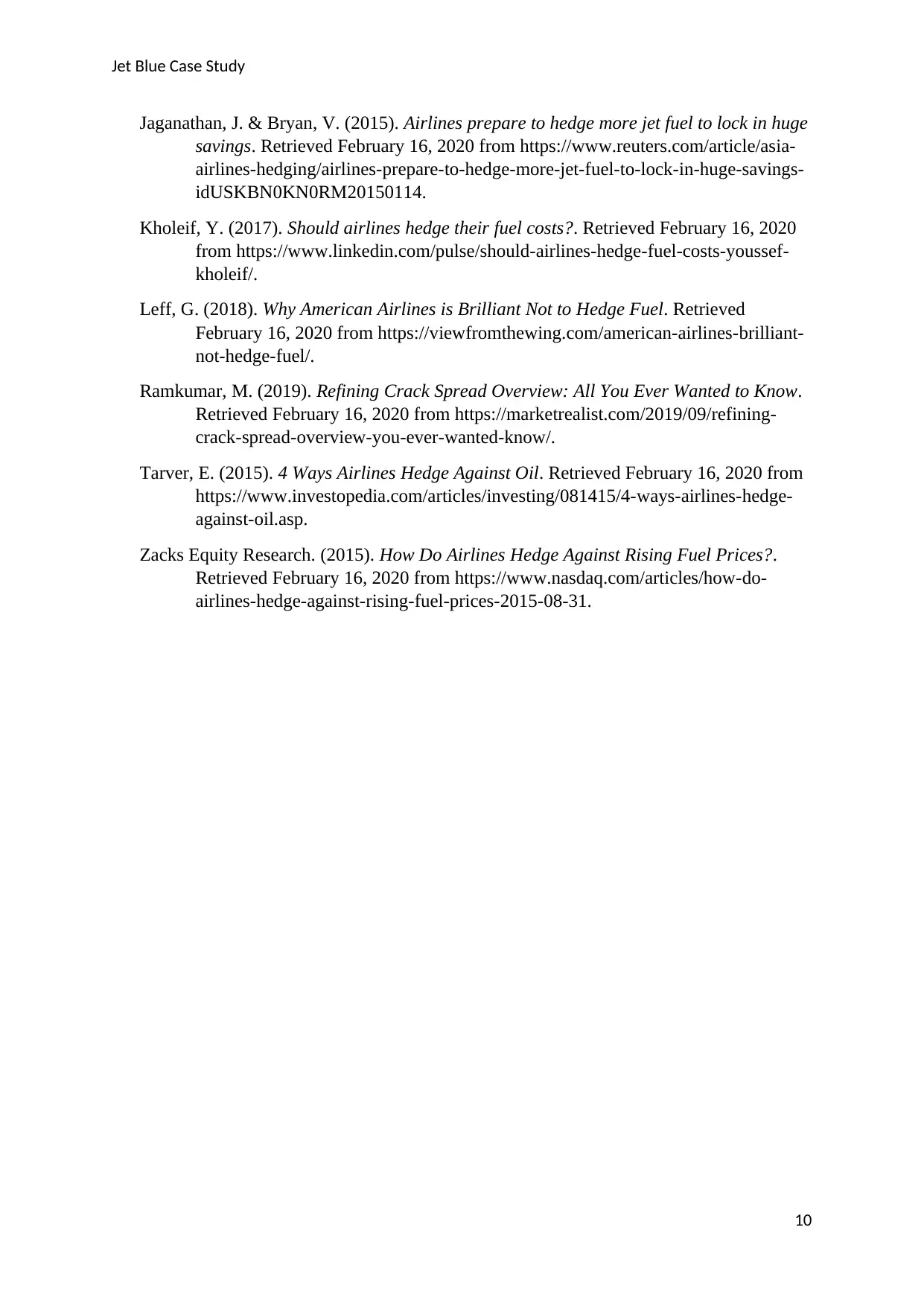
Jet Blue Case Study
Jaganathan, J. & Bryan, V. (2015). Airlines prepare to hedge more jet fuel to lock in huge
savings. Retrieved February 16, 2020 from https://www.reuters.com/article/asia-
airlines-hedging/airlines-prepare-to-hedge-more-jet-fuel-to-lock-in-huge-savings-
idUSKBN0KN0RM20150114.
Kholeif, Y. (2017). Should airlines hedge their fuel costs?. Retrieved February 16, 2020
from https://www.linkedin.com/pulse/should-airlines-hedge-fuel-costs-youssef-
kholeif/.
Leff, G. (2018). Why American Airlines is Brilliant Not to Hedge Fuel. Retrieved
February 16, 2020 from https://viewfromthewing.com/american-airlines-brilliant-
not-hedge-fuel/.
Ramkumar, M. (2019). Refining Crack Spread Overview: All You Ever Wanted to Know.
Retrieved February 16, 2020 from https://marketrealist.com/2019/09/refining-
crack-spread-overview-you-ever-wanted-know/.
Tarver, E. (2015). 4 Ways Airlines Hedge Against Oil. Retrieved February 16, 2020 from
https://www.investopedia.com/articles/investing/081415/4-ways-airlines-hedge-
against-oil.asp.
Zacks Equity Research. (2015). How Do Airlines Hedge Against Rising Fuel Prices?.
Retrieved February 16, 2020 from https://www.nasdaq.com/articles/how-do-
airlines-hedge-against-rising-fuel-prices-2015-08-31.
10
Jaganathan, J. & Bryan, V. (2015). Airlines prepare to hedge more jet fuel to lock in huge
savings. Retrieved February 16, 2020 from https://www.reuters.com/article/asia-
airlines-hedging/airlines-prepare-to-hedge-more-jet-fuel-to-lock-in-huge-savings-
idUSKBN0KN0RM20150114.
Kholeif, Y. (2017). Should airlines hedge their fuel costs?. Retrieved February 16, 2020
from https://www.linkedin.com/pulse/should-airlines-hedge-fuel-costs-youssef-
kholeif/.
Leff, G. (2018). Why American Airlines is Brilliant Not to Hedge Fuel. Retrieved
February 16, 2020 from https://viewfromthewing.com/american-airlines-brilliant-
not-hedge-fuel/.
Ramkumar, M. (2019). Refining Crack Spread Overview: All You Ever Wanted to Know.
Retrieved February 16, 2020 from https://marketrealist.com/2019/09/refining-
crack-spread-overview-you-ever-wanted-know/.
Tarver, E. (2015). 4 Ways Airlines Hedge Against Oil. Retrieved February 16, 2020 from
https://www.investopedia.com/articles/investing/081415/4-ways-airlines-hedge-
against-oil.asp.
Zacks Equity Research. (2015). How Do Airlines Hedge Against Rising Fuel Prices?.
Retrieved February 16, 2020 from https://www.nasdaq.com/articles/how-do-
airlines-hedge-against-rising-fuel-prices-2015-08-31.
10
1 out of 11
Related Documents
Your All-in-One AI-Powered Toolkit for Academic Success.
+13062052269
info@desklib.com
Available 24*7 on WhatsApp / Email
![[object Object]](/_next/static/media/star-bottom.7253800d.svg)
Unlock your academic potential
Copyright © 2020–2025 A2Z Services. All Rights Reserved. Developed and managed by ZUCOL.




